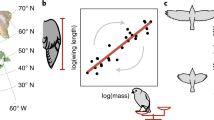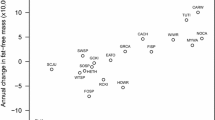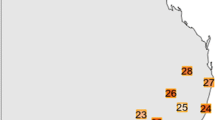Abstract
Declining body size has been suggested to be a response of animals to global warming, but analyses of time series have led to contradictory results. One problem is that each trait related to body size may vary in response to factors other than temperature and independently of size. We analyse trends of three morphological traits of a passerine bird species: the Stonechat Saxicola torquata. Wing lengths were increasing and tail length mostly decreasing between 1989 and 2012. Variation in tarsus length showed no consistent trend. Wing length increased with increasing temperature. Concomitant decreasing tail length suggests, however, that increasing wing length cannot be explained by increasing temperatures during the study period. As tarsus length is a surrogate for overall size, we argue that there was no detectable trend in body size. Wing and tail length are related to flight performance, and increasing wing and decreasing tail length could be indicative of selection for more effective flight, related to either longer migration distances or increased predation pressure. The first scenario is unlikely given the strong suggestions of reduced migratory activity in birds as a response to climate change. The density of the Sparrowhawk Accipiter nisus recently increased almost tenfold in the study area, but the hypothesis of changing morphology as a response to increasing predation pressure remains to be tested. Our study suggests, however, that linking fluctuating lengths in single morphological traits to body size change as a response to global warming may be premature when alternative hypotheses are not considered.
Zusammenfassung
Morphologische Veränderungen beim Schwarzkehlchen Saxicola torquata : eine Folge des Klimawandels?
Die Abnahme der Körpergröße wurde als eine der möglichen Reaktion von Tieren auf die globale Erwärmung angesehen, entsprechende Studien kamen jedoch zu widersprüchlichen Ergebnissen. Ein Problem dabei ist, dass verschiedene angenommene Größenindikatoren in Abhängigkeit von anderen Umweltfaktoren und unabhängig von Temperaturen fluktuieren können. Wir untersuchten die Trends von drei morphologischen Variablen beim Schwarzkehlchen Saxicola torquata. Zwischen 1989 und 2012 nahm die Flügellänge zu und die Länge der Steuerfedern ab, während die Tarsuslänge ohne klaren Trend fluktuierte. Die Flügellänge nahm mit steigenden Temperaturen zu. Die mit steigenden Temperaturen kürzer werdenden Steuerfedern zeigen jedoch, dass die zunehmende Flügellänge nicht durch steigende Temperaturen erklärt werden kann. Da die Tarsuslänge als Größenmaß gilt, ist davon auszugehen, dass kein Veränderung der Körpergröße statt gefunden hat. Längere Flügel und kürzere Steuerfedern deuten die Selektion auf einen effektiveren Flug an, als mögliche Anpassung an einen längeren Zugweg oder steigenden Prädationsdruck. Ersteres erscheint unwahrscheinlich im Hinblick auf die generell abnehmenden Zugdistanzen von Vögeln als Reaktion auf den Klimawandel. Die Dichte des Sperbers Accipiter nisus hat im Untersuchungsgebiet annähernd zehnfach zugenommen. Ob morphologische Änderungen als Anpassung an einen gestiegenen Prädationsdruck stattfinden, muss aber noch geprüft werden. Die Studie weist jedoch darauf hin, dass es kritisch ist, Veränderungen einzelner morphologischer Variablen als Anpassungen an den Klimawandel zu interpretieren, wenn alternative Hypothesen nicht berücksichtigt werden.



Similar content being viewed by others
References
Ashton JC, Armstrong DP (2002) Facultative prioritization of wing growth in the Welcome Swallow Hirundo neoxena. Ibis 144:470–477
Barry JP, Baxter CH, Sagarin RD, Gilman SE (1995) Climate related, long-term faunal changes in a California rocky intertidal community. Science 267:672–675
Bergmann C (1847) Ueber die Verhältnisse der Wärmeökonomie der Thiere zu ihrer Grösse. Göttinger Stud 1:595–708
Berthold P (1976) Über den Einfluß der Nestlingsnahrung auf die Jugendentwicklung, insbesondere auf das Flügelwachstum, bei der Mönchsgrasmücke. Vogelwarte 28:257–263
Berthold P, Friedrich W (1979) Die Federlänge: ein neues nützliches Flügelmaß. Vogelwarte 30:11–21
Bezzel E (1995) Werden neuerdings aus Italien keine Wiederfunde beringter Vögel mehr gemeldet? Vogelwarte 38:106–107
Brotons L, Jiguet F (2010) Bird communities and climate change. In: Møller AP, Fiedler W, Berthold P (eds) Effects of climate change on birds. Oxford University Press, Oxford, pp 275–294
Chmielewski F-M, Rötzer T (2001) Response of tree phenology to climate change across Europe. Agric For Meteorol 108:101–112
Desrochers A (2010) Morphological response of songbirds to 100 years of landscape change in North America. Ecology 91:1577–1582
Dhondt AA (1983) Variations in the number of overwintering Stonechats possibly caused by natural selection. Ringing Migr 4:155–158
Dunn PO, Winkler DW (2010) Effects of climate change on timing of breeding and reproductive success in birds. In: Møller AP, Fiedler W, Berthold P (eds) Effects of climate change on birds. Oxford University Press, Oxford, pp 113–128
Fiedler W (2003) Recent changes in migratory behaviour of birds: a compilation of field observations and ringing data. In: Berthold P, Gwinner E, Sonnenschein E (eds) Avian migration. Springer, New York, pp 21–37
Fiedler W (2005) Ecomorphology of the external flight apparatus of blackcaps (Sylvia atricapilla) with different migration behaviour. Ann NY Acad Sci 1046:253–263
Fitzpatrick S (1999) Tail length in birds in relation to tail shape, general flight ecology and sexual selection. J Evol Biol 12:49–60
Flinks H (1994) Die Altersbestimmung des Schwarzkehlchens Saxicola torquata an Gefiedermerkmalen. Limicola 8:28–37
Flinks H (1999) Muster, Intensität und zeitliche Aspekte der postjuvenilen Mauser beim Schwarzkehlchen (Saxicola torquata). Vogelwarte 40:11–27
Flinks H (2012) Zunehmende Überwinterrungen von Schwarzkehlchen Saxicola torquata im nordwestlichen Nordrhein-Westfalen. Vogelwarte 50:280–281
Flinks H, Salewski V (2012) Quantifying the effect of feather abrasion on wing and tail lengths measurements. J Ornithol 153:1053–1065
Förschler MI, Bairlein F (2011) Morphological shifts of the external flight apparatus across the range of a passerine (Northern Wheatear) with diverging migratory behaviour. PLoS ONE 6:e18732
Freeman S, Jackson WM (1990) Univariate metrics are not adequate to measure avian body size. Auk 107:69–74
Gardner JL, Heinsohn R, Joseph L (2009) Shifting latitudinal clines in avian body size correlate with global warming in Australian passerines. Proc R Soc Lond B 276:3845–3852
Gardner JL, Peters A, Kearney MR, Joseph L, Heinsohn R (2011) Declining body size: a third universal response to warming? Trends Ecol Evol 26:285–291
Goodman RE, Lebuhn G, Seavy NE, Gardali T, Bluso-Demers JD (2012) Avian body size and climate change: warming or increasing variability. Glob Change Biol 18:63–73
Gosler AG, Greenwood JJD, Baker JK, Davidson NC (1998) The field determination of body size and condition in passerines: a report to the British Ringing Committee. Bird Study 45:92–103
Hassall C, Thompson DJ, French GC, Harvey IF (2007) Historical changes in the phenology of British Odonata are related to climate. Glob Change Biol 13:933–941
Hedenström A, Möller AP (1992) Morphological adaptations to song flight in passerine birds: a comparative study. Proc R Soc Lond B 247:183–187
Helm B, Fiedler W, Callion J (2006) Movements of European stonechats Saxicola torquata according to ringing recoveries. Ardea 94:33–44
Hickling R, Roy DB, Fox R, Thomas CD (2006) The distributions of a wide range of taxonomic groups are expanding polewards. Glob Change Biol 12:450–455
IPCC (2007) Climate Change 2007. Cambridge University Press, Cambridge
Jakober H, Stauber W (2000) Werden die Neuntöter (Lanius collurio) kleiner? J Ornithol 141:408–417
Kipp FA (1958) Zur Geschichte des Vogelzuges auf der Grundlage der Flügelanpassungen. Vogelwarte 19:233–242
Korner-Nievergelt F, Sauter A, Atkinson PW, Guélat J, Kania W, Kéry M, Köppen U, Robinson RA, Schaub M, Thorup K, van der Jeugd H, van Noordwijk AJ (2010) Improving the analysis of movement data from marked individuals through explicit estimation of observer heterogeneity. J Avian Biol 41:8–17
Leisler B, Winkler H (1985) Ecomorphology. Curr Ornithol 2:155–186
Leisler B, Winkler H (2003) Morphological consequences of migration in Passerines. In: Berthold P, Gwinner E, Sonnenschein E (eds) Avian migration. Springer, New York, pp 175–186
McNab B (2010) Geographic and temporal correlations of mammalian size reconsidered: a resource rule. Oecologia 164:13–23
Milá B, Wayne RK, Smith TB (2008) Ecomorphology of migratory and sedentary populations of the yellow-rumped warbler (Dendroica coronata). Condor 110:335–344
Mildenberger H (1982) Die Vögel des Rheinlandes. Band I: Seetaucher bis Alken (Gaviiformes—Alcidae). Beitr Avifauna Rheinlandes 16–18:1–400
Moreno-Rueda G (2003) The capacity to escape from predators in Passer domesticus: an experimental study. J Ornithol 144:438–444
Moreno-Rueda G, Rivas JM (2007) Recent changes in allometric relationships among morphological traits in the dipper (Cinclus cinclus). J Ornithol 148:489–494
Müller C, Jenni-Eiermann S, Jenni L (2009) Effects of a short period of elevated circulating corticosterone on postnatal growth in free-living Eurasian kestrels Falco tinnunculus. J Exper Biol 212:1405–1412
Norberg UM (1995) How a long tail and changes in mass and wing shape affect the cost for flight in animals. Funct Ecol 9:48–54
Piersma T, Davidson NC (1991) Confusions on mass and size. Auk 108:441–444
R Development Core Team (2010) R: a language and environment for statistical computing. R Foundation for Statistical Computing, Vienna
Rising JD, Somers KM (1989) The measurement of overall body size in birds. Auk 106:666–674
Salewski V, Hochachka W, Fiedler W (2010) Global warming and Bergmann’s rule: do central European passerines adjust their body size to rising temperatures? Oecologia 162:247–260
Senar JC, Pascual J (1997) Keel and tarsus length may provide a good predictor of avian size. Ardea 85:269–274
Sheridan JA, Bickford D (2011) Shrinking body size as an ecological response to climate change. Nat Clim Change 1:401–406
Svensson L (1992) Identification guide to European passerines. Svensson, Stockholm
Teplitsky C, Mills JA, Alho JS, Yarrall JW, Merilä J (2008) Bergmann’s rule and climate change revisited: disentangling environmental and genetic responses in a wild bird population. Proc Natl Acad Sci USA 105:13492–13496
Thomas CD, Franco AMA, Hill JK (2006) Range retractions and extinction in the face of climate warming. Trends Ecol Evol 21:415–416
Tornberg R, Mönkkönen M, Pahkala M (1999) Changes in diet and morphology of Finnish goshawks from 1960s to 1990s. Oecologia 121:369–376
van Balen JH (1967) The significance of variations in body weight and wing length in the great tit, Parus major. Ardea 55:1–59
van Buskirk J, Mulvihill RS, Leberman RC (2010) Declining body sizes in North American birds associated with climate change. Oikos 119:1047–1055
van Vliet J, Muster CJM, Ter Keurs WJ (2009) Changes in migration behaviour of blackbirds Turdus merula from the Netherlands. Bird Study 56:276–281
Vanhooydonck B, Herrel A, Gabela A, Podos J (2009) Wing shape variation in the median ground finch (Geospiza fortis): an ecomorphological approach. Biol J Linn Soc 98:129–138
Visser ME, Perdeck AC, van Balen JH, Both C (2009) Climate change leads to decreasing bird migration distances. Glob Change Biol 15:1859–1865
Wink M, Dietzen C, Gießing B (2005) Die Vögel des Rheinlandes. Atlas zur Brut- und Wintervogelverbreitung 1990 bis 2000. Romneya and NIBUK, Dossenheim and Neunkirchen
Winkler H, Leisler B (1992) On the ecomorphology of migrants. Ibis 134(Suppl. 1):21–28
Wood S (2006) Generalized additive models: an introduction to R. Chapman & Hall, CRC, London
Woodall CW, Oswalt CM, Westfall JA, Perry CH, Nelson MD, Finley AO (2009) An indicator of tree migration in forests of the eastern United States. For Ecol Manag 257:1434–1444
Yom-Tov Y, Geffen E (2011) Recent spatial and temporal changes in body size of terrestrial vertebrates: probable causes and pitfalls. Biol Rev 86:531–541
Yom-Tov Y, Yom-Tov S, Wright J, Thorne CJR, du Feu R (2006) Recent changes in body weight and wing length among some British passerine birds. Oikos 112:91–101
Yong W, Moore FR (1994) Flight morphology, energetic condition, and the stopover biology of migrating thrushes. Auk 111:683–692
Acknowledgments
The Institute of Avian Research “Vogelwarte Helgoland” provided H.F. with Helgoland rings. R. Schlenker and K.-H. Siebenrock, Max-Planck-Institute for Ornithology, Radolfzell, provided H.F. with some trapping equipment. The farmers of the Düffel and the Heubach-Lowland generously allowed working on their estates. R. Fischer, Bocholt-Loeverick, kindly provided the data from his private weather station. The data analysis for this project was supported by a grant from the Deutsche Ornithologen-Gesellschaft (DO-G).
Author information
Authors and Affiliations
Corresponding author
Electronic supplementary material
Below is the link to the electronic supplementary material.
Rights and permissions
About this article
Cite this article
Salewski, V., Hochachka, W.M. & Flinks, H. Changes in Stonechat Saxicola torquata morphology: a response to climate change?. J Ornithol 155, 601–609 (2014). https://doi.org/10.1007/s10336-014-1042-z
Received:
Revised:
Accepted:
Published:
Issue Date:
DOI: https://doi.org/10.1007/s10336-014-1042-z




